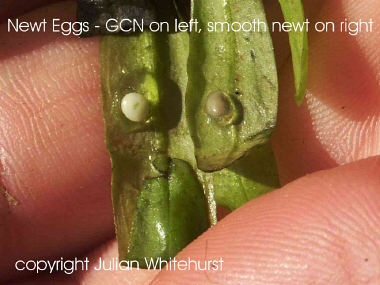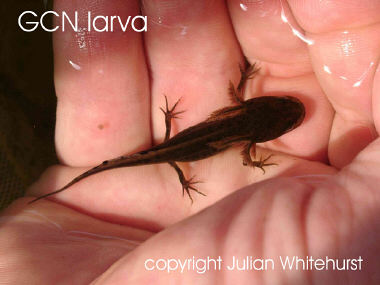GREAT CRESTED NEWT (TRITURUS CRISTATUS)
LOCAL BIODIVERSITY ACTION PLAN
Links to associated HAPs
Ponds
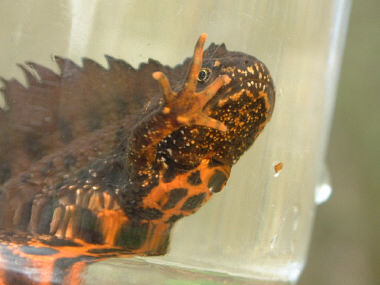 Current Status
Current Status
An internationally important species of conservation concern. Since the late 1940's great crested newt (GCN) populations have experienced drastic declines throughout much of Europe, although populations are still found in many parts of the country.
Distribution is widespread throughout the Cheshire region, probably due to relative abundance of farm ponds and suitable terrestrial habitat throughout the region. A three year survey (1995/6/7) of 370 ponds in Cheshire found that 32.9% of those ponds surveyed supported populations of GCN and almost half the ponds which contained amphibians held Great Crested Newts (Pond Life Project, Critical Pond Biodiversity Survey, 1997).
The GCN is protected under Annex IIa and IVa of the EU Habitats and species Directive, Appendix II of the Bern Convention (SI 1994 No. 2716) and by Schedules 5 and 9 of the Wildlife and Countryside Act 1981.
Threats
- Loss and fragmentation of suitable aquatic and terrestrial habitat due to natural succession, construction developments, recreational usage, land drainage, water abstraction and the in-filling of ponds and ditches as a result of agricultural intensification/diversification
- Introduction of predators, e.g. stocking of fish, wildfowl, etc.
- Decline in the water quality of ponds due to eutrophication and pollution from agricultural and industrial chemicals and waste
- Inappropriate management of know GCN sites
- Poor quality mitigation schemes e.g. insufficient provision of terrestrial habitat and inappropriate pond designs (which favour fish introduction)
How are we helping to conserve the Great Crested Newt in the Cheshire region?
- Great crested newt mitigation projects have taken place where construction development has impacted upon existing populations of GCN and their habitat.
- The Local Records Centre, rECOrd, is compiling records for this species. Please send details of all sightings to rECOrd.
- Julian Whitehurst has been appinted area representative for Cheshire & North Wales by the Herpetofauna Group of Britain and Northern Ireland.
- Cheshire and Wirral Amphibian and Reptile Group respond to calls from the general public.
Objectives, Targets and Actions
OBJECTIVES |
LOCAL TARGETS |
To halt and reverse the decline of great crested newt populations in the Cheshire region. |
Targets awaited |
ACTIONS REQUIRED |
- Form links with the Ponds BAP.
- Work with Ecological Consultants, Local Planning Authorities and developers to encourage early site appraisal in the planning process and maximise any mitigation that may be required.
- Establih a voluntary survey team and set achievable survey targets, monitor and re-assess the status of GCN in the Cheshire region.
- Identify critical populations and associated habitats, aquatic and terrestrial.Record GCN sites on a computer database e.g. Recorder and GIS.Co-ordinate a targeted programme of pond restoration/creation within strategic areas to expand the range of existing GCN metapopulations.Promote the appropriate management of existing ponds and surrounding terrestrial habitat where populations of GCN are known to exist.Protect actual or potential GCN sites from damage or destruction where possible. Where loss is unavoidable new areas of suitable terrestrial and aquatic habitat should be created nearby. Maintain a register of translocated populations and assess their viability.Raise awareness of the importance of GCN conservation and the dependence of this species on wetland and terrestrial.Raise awareness of GCN legislation with landowners, managers, developers, etc.Evaluate and implement criteria for the designation of sites of importance for GCN.Encourage the listing of GCN translocation sites as Sites of Biological Importance (SBIs) to highlight their existence and importance to local planning authorities developers, etc.
- Working with schools and education groups to promote and publicise GCN and pond conservation in general
|
Progress so far
2005 Action Completed |
- Awareness of species and habitat issues has been raised with local planning authorities resulting in the increased use of appropriate planning conditions to protect GCNs and their habitat.
- Copies of GCN handbook have been supplied to a number of landowners and members of the public. The action group coordinator attended national Herpetofauna Workers’ Conference.An advanced GCN survey training course in conjunction with CCW and North Wales Amphibian and Reptile Network has been run. Proposals for a GCN conservation project have been discussed with Andrew Hull of Liverpool John Moores University. Advice has been provided to members of the public on GCN conservation, habitat management and protection. The action group coordinator attended the SEMMS steering group meetings to encourage implementation of appropriate mitigation measures on new road construction scheme.
- Amendments have been suggested to the GCN mitigation guidelines.
|
1997-2004 Action Completed |
- A BAP Action Group has now been formed.
English Nature has produced the 'Great crested newt mitigation guidelines' document.
Froglife have published the 'Great crested newt conservation handbook'.
- Species recording card for great crested newts produced by Cheshire County Council and Vale Royal Borough Council.
|
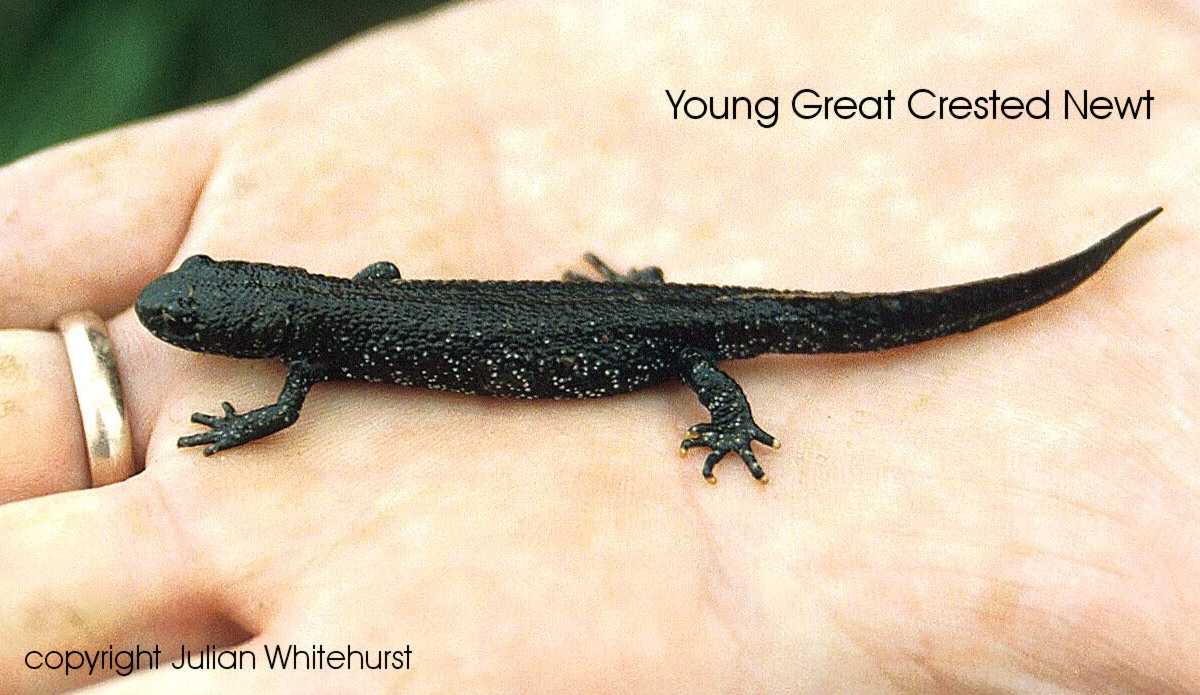 |
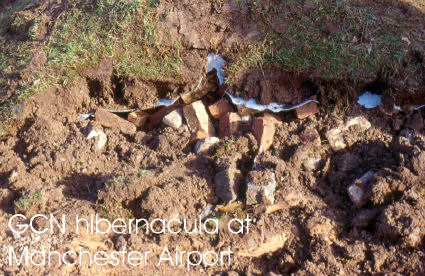 |
How to find out more about Great Crested Newts
Vale Royal Borough Council Great Crested Newt Species Recording card
Natural England Great Crested Newt Mitigation Guidleines - www.english-nature.org.uk/pubs/publication/PDF/GCN0801w.PDF
Wirral Biodiversity Action Plan for Great Crested Newts can be seen at www.wirral.gov.uk/ed/biodiversity/gcn.htm
Herpetological Conservation Trust - www.herpconstrust.org.uk/index.php
UK BAP for Great Crested Newts - www.ukbap.org.uk/UKPlans.aspx?ID=619
How can you get involved?
Join the Cheshire and Wirral Amphibian and Reptile Group, ask Julian Whitehurst for details.
Contact details
| LBAP Chair |
Julian Whitehurst, Cheshire Ecological Services
Phone: 01829 770797
Fax: 01829 720263 |
National Lead Partner |
Herpetological Conservation Trust
Froglife
British Herpetological Society |
| National Contact |
Jim Foster, Natural England
Phone: 01733 455251 |
References & Glossary
Great Crested Newt Species Action Plan Forum (1997): U.K. Great Crested Newt Triturus cristatus Species Action Plan Programme 1998-2002. Unpublished.
English Nature (1994): Conservation and Management of great-crested newts; Proceedings of a symposium held on the 11th January 1994 at Kew Gardens, Richmond, Surrey No. 20.
HMSO (1995): Biodiversity: The UK Steering Group Report, Volume 1: Meeting the Rio Challenge, London.
HMSO (1995): Biodiversity: The UK Steering Group Report, Volume 2:Action Plans, London.
Guest, J. & Bentley, D. (1998): Critical Pond Biodiversity Survey 1997, Pond Life Project, Liverpool John Moores University, Liverpool
Joint Nature Conservation Committee (1994): A Framework for the Conservation of Amphibians and Reptiles in the U.K. 1994-1999.
JNCC (1998): Herpetofauna Workers Manual.
English Nature (2001) Great crested newt mitigation guidelines.
Froglife (2002) Great crested newt conservation handbook


 Current Status
Current Status